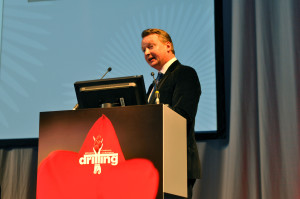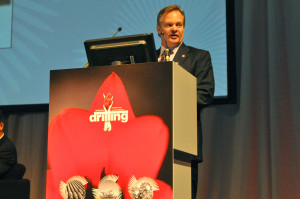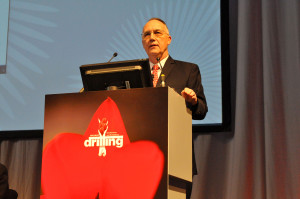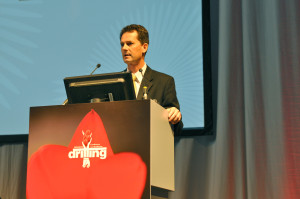Plenary: Enhanced operational integrity to help industry deliver wells in ‘critical world’

By Joanne Liou, associate editor
Driven by increasing worldwide demand, the challenges industry faces are becoming more pronounced. “We need to bring on about 27 million barrels per day of new production over the next seven years in order to meet 1% to 2% demand growth per year,” Ole Slorer, managing director, global oilfield services for Morgan Stanley Research, stated at the 2013 SPE/IADC Drilling Conference. Mr Slorer moderated the plenary session, “Delivering Wells in a Critical World,” in Amsterdam on 6 March. Two of the biggest growing segments that will help the industry meet the world’s energy demand are ultra-deepwater and liquids from shale plays, he said. However, the extraction of those resources presents increasing environmental risks and complexities in well design.
In a wide-ranging plenary session, Scott Sigurdson, vice president, area wells – deepwater at BP Global Wells Organization; Øyvind Tuntland, vice president of Petroleum Safety Authority (PSA); Lyndol Dew, senior vice president of worldwide operations at Diamond Offshore Drilling; Rosli Hamzah, head of well delivery at PETRONAS; and Steve Orr, drilling group president for Schlumberger; addressed how industry is approaching these challenges.

Many steps are taken to ensure the long-term integrity of a well, from identifying methods to be used in well construction to involving regional engineering specialists. In part, BP has targeted the challenge through cementing, making cementing a formal sub-discipline and establishing a competency framework with structured development and career opportunities. “An in-house advanced cementing course is near completion to reinforce requirements and deepen proficiency across a broad range of cementing challenges,” Mr Sigurdson explained.
To further ensure performance, the company uses an independent safety and operational risk authority to verify that requirements are being met. “If a well does not initially conform to our internal standards, a formal risk assessment is done to determine the forward plan. We’re also systematically auditing our cementing suppliers globally, with a focus on competency and compliance with their internal design and approval processes.”
Another key focus is well control competency development in deepwater. At BP’s Global Wells Institute in Houston, a simulator was recently installed to complement a new applied well control training course. “The training is unique and trains key rig personnel, including BP drilling and rig services staff, in a team environment where we simulate potential well control challenges,” Mr Sigurdson said.
Beyond individual company initiatives, industry also must push for collaboration on critical issues. “It’s important we work with all our contractors to manage risk with a one-team approach. We need all people involved in support of the well to be focused and working together toward safe and reliable operations,” he continued. Several examples of industry collaboration targeting deepwater accident and prevention response capabilities have already been established, such as the Subsea Well Response Group and the US Center for Offshore Safety.
Another example of industry collaboration is the PSA, which continues to interact with groups, such as the International Regulators Forum and the North Sea Offshore Authorities Forum, to better navigate technical and operational risks and public expectations. Last year, the Norwegian regulator began to form multinational audits, which focus on sequences, action, discussion and organization, for different aspects of a drilling operation, such as well control procedures and communication between client, drilling contractor and service contractors.
In terms of barrier management, PSA’s well control incident studies found that there is more focus “on improving handling of a well control situation rather than on preventing a situation in the first place,” Mr Tuntland explained. “We think there should be stronger emphasis on technical lectures to improve safety.” He also reported that the OGP Wells Expert Committee continues to analyze BOP reliability, but there have been no formal results yet.

There is also a growing interest in crew resource management (CRM), which focuses on development of non-technical skills, human factors, interpersonal communication, teamwork, situation awareness, stress management, leadership and decision making. CRM was originally developed for aviation, but “many players, such as OGP and regional gas associations, have put CRM on the agenda to assess possible application in the oil and gas industry,” Mr Tuntland said. “If we’re going to increase staff offshore, we need to look at our training, and we need to look at crew-based simulation training. We urge the drilling industry to simulate further to more crew-based simulation training.”
The public’s concerns about industry practices are well recognized, but “What does the public really want from drilling contractors?” was the question that Mr Dew posed. The answer is simple, he believes: invisibility. “They don’t want to hear from us; they don’t want us to cause problems. They just want us to do our job and deliver the fuel,” he said.
Mr Dew also discussed Diamond Offshore’s journey toward improved process safety. After a 2005 incident in Texas, it was reported that the companies involved concentrated too much on personnel safety and not enough on process safety. “I gathered my team shortly after reading that report and said, ‘Hey, could this be us? Are we so concerned about the bubble of loss of life and the actual level of slips, trips and falls and LTIR frequency rates that we’re missing the big picture?’” The company then went to work on defining process safety for drilling contractors, concluding that “our processes are the things that we do to prevent multiple fatalities,” he said.
The company ultimately established three fleet integrity assurance goals:
- Keep the pointy end up, referring to the derrick.
- Keep hydrocarbons where they belong.
- Don’t give up the ship.
Looking forward, Diamond Offshore is working on defining each individual’s role – down to the roustabout and roughneck – in meeting the three goals, Mr Dew noted.

For PETRONAS, the company knows well that its own success or failure has significant influence on Malaysia. “We are owned by people of Malaysia, and 40% of Malaysian revenues come from PETRONAS. We carry a very heavy social responsibility,” Mr Hamzah said.
PETRONAS’ well integrity assurance program begins with a technology peer review. All designs go through peer review by experts and engineers on various well components, as well as through reviews by in-house independent review committees, Mr Hamzah said. “We consider a well kick equivalent to a lost-time incident,” Mr Hamzah noted. “We investigate all well kicks.”
Providing a service company perspective, Mr Orr described the gradual shift at Schlumberger to competence assurance. This takes personnel beyond simple training or certification. “We’re moving from certified training to high-risk operation competency assurance,” he said. “We’re now checking competencies.”

Such assurances of competence are especially important for ensuring well integrity, and the company has established corporate standards that cross multiple segments within Schlumberger. “Corporate standards bridge across operations, training and verification of what’s done,” Mr Orr explained. “We have who is responsible in terms of operations, in terms of manufacturing to ensure that we have accountability, but on top of that, we can manage the change and management aspect of it.”
The company also has embarked on an integrated drilling strategy to enhance the value that its discrete products and services can bring to operators. “It’s a systems approach that is going to make the next step-change,” Mr Orr stated. “It’s the alignment of all the stakeholders that will bring the next step-change in operational integrity.”
Watch an exclusive video interview with Steve Orr about Schlumberger’s integrated drilling strategy.




